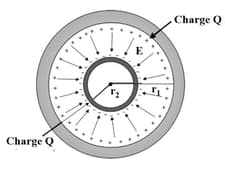HARD
12th Assam Board
IMPORTANT
Earn 100
Show that the force on each plate of a parallel plate capacitor has a magnitude equal to , where is the charge on the capacitor, and is the magnitude of electric field between the plates. Explain the origin of the factor .

Important Questions on Electrostatic Potential and Capacitance
MEDIUM
12th Assam Board
IMPORTANT
A spherical capacitor consists of two concentric spherical conductors, held in position by suitable insulating supports. Show that the capacitance of a spherical capacitor is given by where and are the radii of outer and inner spheres, respectively.

HARD
12th Assam Board
IMPORTANT
A spherical capacitor has an inner sphere of radius and an outer sphere of radius . The outer sphere is earthed, and the inner sphere is given a charge of . The space between the concentric spheres is filled with a liquid of dielectric constant . Determine the capacitance of the capacitor. Also, what is the potential of the inner sphere. Compare the capacitance of this capacitor with that of an isolated sphere of radius 12 cm. Explain why the latter is much smaller.
EASY
12th Assam Board
IMPORTANT
Two large conducting spheres carrying charges and are brought close to each other. Is the magnitude of electrostatic force between them exactly given by where is the distance between their centers?
EASY
12th Assam Board
IMPORTANT
If Coulomb’s law involved dependence (instead of ), would Gauss’s law be still true?
EASY
12th Assam Board
IMPORTANT
A small test charge is released at rest at a point in an electrostatic field configuration. Will it travel along the field line passing through that point?
MEDIUM
12th Assam Board
IMPORTANT
What is the work done by the field of a nucleus in a complete circular orbit of the electron? What if the orbit is elliptical?
MEDIUM
12th Assam Board
IMPORTANT
We know that electric field is discontinuous across the surface of a charged conductor. Is electric potential also discontinuous there?
EASY
12th Assam Board
IMPORTANT
What meaning would you give to the capacitance of a single conductor?
